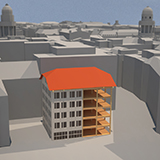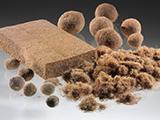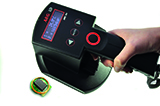Fraunhofer BuildingProduct and system solutions for greater energy and resource efficiency
It is calculated that Earth will be home to an additional three billion people by 2050. Current developments and forecasts indicate that most of them will be living and working in urban environments. According to estimates, this will be accompanied by a massive rise in demand for primary energy and a corresponding increase in CO2 emissions. This is why governments worldwide are already making efforts today – partly through ambitious climate protection policies – to ensure that current and future generations have a sustainable future. Many of the key levers for achieving this are located in cities themselves and will be based around things like energy-efficient industries, carbon-neutral traffic flows, and climate-friendly residential and commercial buildings. At its special “Research City Workshop” show at BAU 2015 (Hall C2, Booth 118/119), the Fraunhofer Building Innovation Alliance will be showcasing technological solutions and answers to the global megatrends.
“Scarce and expensive raw materials, rising energy prices, and tougher climate protection requirements are presenting the construction industry with big challenges. Around 40 percent of the energy used in industrialized countries goes on heating and cooling. The building sector, which consumes roughly 50 percent of all raw materials and produces about 60 percent of all waste, is the key partner for addressing this situation. New building systems that reduce energy consumption, research into innovative building materials, and the careful, forward-looking planning of buildings, residential areas, and cities are all equally essential”, summarizes Prof. Dr.-Ing. Alexander Verl, Executive Vice President Technology Marketing and Business Models of the Fraunhofer-Gesellschaft.
What does that mean for the urban future? When planning, building, and running buildings, a wide variety of aspects of diverse origin must be taken into account, requirements that can no longer be fulfilled without the synergetic interplay of architecture, structural engineering, building services, and urban planning.
Spread over the four subject zones of Construction Materials, Building Systems, Safety, and Morgenstadt (City of the Future), a total of 18 Fraunhofer research institutions are showcasing 44 product and system solutions for the construction industry at the special “Research City Workshop” show in Hall C2 (Booth 118/119). In addition, experts from the Fraunhofer Building Innovation Alliance will be presenting results of their research in Forum B0 – From Vision to Reality.
Construction materials
The quality of a building depends directly on the properties of the construction materials used. Efficient use of energy and materials and the environmental and health impact of construction materials are key concerns of the building research carried out at Fraunhofer, which takes the tried-and-tested properties of traditional construction materials and combines them with additional features in targeted further development strategies.
The Fraunhofer Institute for Wood Research WKI is showing visitors to BAU 2015 the vision of a multifunctional façade based on renewable raw materials that is sustainable in terms of energy and general ecological performance. As well as providing the traditional protection against the elements, innovative multifunctional facades also incorporate building services. In addition, energy can be generated through solar thermal and photovoltaic systems on building surfaces.
One of the main focuses of research and development work at the Fraunhofer Institute for Chemical Technology ICT is the properties of Neptune grass (Posidonia oceanica). This seagrass is an attractive prospect for the building industry because its fibers are virtually non-flammable. As it is also resistant to mold, it can be used as insulating material without the need for chemical additives – for example, as insulation between the rafters of pitched roofs, to insulate interior walls, or to reduce the amount of heat lost through building envelopes. The fibers act as a buffer, absorbing water vapor and releasing it again without impairing heat insulation capacity.
Building systems
Prefabricated building components and multifunctional systems now play a major role in the construction industry. The benefits they offer are obvious: above all, greater efficiency and flexibility through cleverly exploited synergy effects.
The Fraunhofer Institute for Solar Energy Systems ISE develops multifunctional and innovative façade solutions. For new buildings and renovations alike, prefabricated façade systems enable ventilation, heating, and sanitary systems to be installed together with the façade’s heat insulation. The installations are brought into the building interior through special window modules. New kinds of building components featuring integrated fluid channels and based on ultra-high-performance concrete (UHPC) can be further developed into building-integrated solar collectors or thermally activated building systems (TABS) for new buildings. Initial prototypes made using a special diaphragm forming technique feature fractal-like channel structures, which were created using the FracTherm® algorithm.
Intensive development and testing of IT-based processes to support the construction industry has been underway for several years. By using open, vendor-neutral e-business standards, building information modeling (BIM) facilitates seamless business processes across different companies and media when planning, implementing, and managing construction projects. The objective is 3D computer-aided draft and final planning in highly networked, intercompany teamwork. This will allow significant increases in efficiency and quality along the entire value-added chain, particularly for the many small and medium-sized businesses in the German construction and real estate industry. The Fraunhofer Institute for Building Physics IBP is the consortium leader in the “BIMiD – BIM Reference Object in Germany” research project sponsored by the German Federal Ministry for Economic Affairs and Energy. In Volkswagen Financial Services’ “House H” new office building project, the contractor is systematically implementing BIM during planning and construction. At their presentations at the BAU 2015 trade fair, Fraunhofer researchers will be focusing particularly on opportunities for improving efficiency during planning and building phases.
Safety
To offer buildings more reliable protection against damage – whether from natural phenomena or terrorist attacks – Fraunhofer institutes are developing innovative materials, sensors, and simulation tools for different types of building structures. The aim is to combine safety issues with quality assurance, architectural design, and building functionality requirements.
At BAU 2015, the Fraunhofer Institute for High-Speed Dynamics, Ernst-Mach-Institut, EMI is presenting the model of a blast simulator that demonstrates the effects of a road accident on built structures in an urban environment. Using the software, the protection concepts developed at Fraunhofer EMI for improving the resistance behavior of masonry, reinforced concrete, and glass façades can be applied to individual building structures. The model visualizes the effect of such protective measures on overall load-bearing behavior depending on the distance between the accident and the building impact site. Visitors to the Fraunhofer stand can actively apply the different protection concepts to the buildings themselves and test their effectiveness.
Reinforced concrete structures such as bridges and parking garages have to cope with the ravages of water and road salt more often than accidents. This kind of damage cannot be recognized from the outside in its early stages. By the time the first concrete slabs crack open because their reinforcement has corroded, it is usually too late for low-cost repairs. In such cases, the structures either need extensive renovation or have to be completely rebuilt from scratch. In cooperation with partners from industry, the Fraunhofer Institute for Microelectronic Circuits and Systems IMS has developed a sensor system that measures moisture and corrosion in the concrete. The sensor can be encased in the concrete during construction or else installed at a later date. It works without batteries, and its data is transmitted via radio signal through the covering concrete, where it can be read on the surface.
Morgenstadt (City of the Future)
How do we want to live and work in the city of tomorrow? Teaming up with cities and industrial companies, the Fraunhofer-Gesellschaft is striving to envision, develop, and implement pioneering urban innovations. At the Fraunhofer Building Innovation Alliance booth, visitors can bring a 3D model of a city to life using a smartphone app, which recognizes the contours of the model structures and projects augmented reality situations for pioneering Morgenstadt projects on the model surfaces. The virtual models give visitors an immersive experience of relevant Morgenstadt topics such as autonomous driving, urban gardening, urban production, and energy generating façades.
Expert forum: From Vision to Reality
Forum B0 at the BAU 2015 trade fair was organized by three institutions: the German Federal Ministry for the Environment, Nature Conservation, Building and Nuclear Safety; Bundesarbeitskreis Altbauerneuerung e.V. (federal task force for the renovation of old buildings); and the Fraunhofer Building Innovation Alliance. Experts will be dispensing advice to visitors here throughout the trade fair, and each new day will be devoted to a different general topic. The full program is available in German.
You can find details in German of all presentations by the various Fraunhofer Building Innovation Alliance representatives here.
Last modified:
 Fraunhofer Building Innovation Alliance
Fraunhofer Building Innovation Alliance

